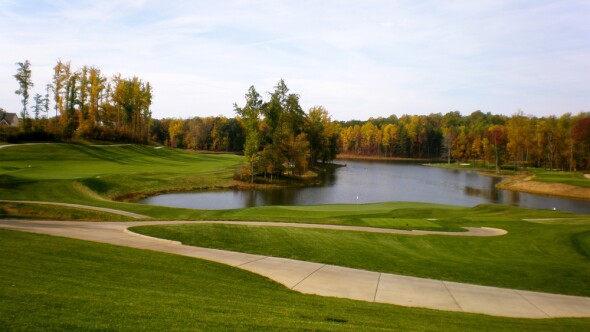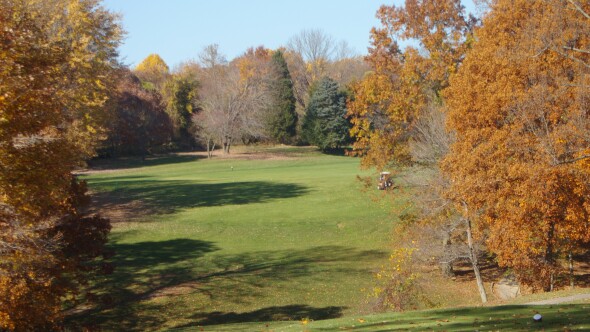Spend any time around military folks, and you're likely to hear a bad joke about the less-stringent physical requirements of the Air Force. If you've never heard the one about an "Air Force push up," it's only because you don't know enough Army soldiers.
True or not, the stereotype is reinforced by the top two military golf facilities of the Washington, D.C., area -- the rigorous 36 holes at Fort Belvoir Golf Club in northern Virginia and the relatively easy 54 holes at Andrews Air Force Base in suburban Maryland.
While the toughest loop at Andrews, the 6,883-yard East Course, is longer than either of the tracks at Belvoir, it has a rating of 71.9 and a slope of 126. Compare that to the beefier numbers of Belvoir's Woodlawn (73.9/133) and Gunston (74.1/135) courses and you have more ammunition for the "grunts" to fire at the "fly boys."
But here's what all Washington, D.C.-area military golfers can agree on: The Courses at Andrews and Belvoir are two of the better military golf facilities in the country.
Golf courses at Andrews Air Force Base
The clubhouse at Andrews looks modest from the huge parking lot, but step inside, and it feels like you've been transported to a private club. With leather sofas, multiple dining rooms, an intimate bar and a big locker room with sauna and fitness center, the Courses at Andrews can accommodate discerning players and lots of them.
With the courses located off the south end of the airfield, one of the thrills of playing Andrews is watching aircraft -- from hulking C-130 transports to shifty F-16 fighters -- fly overhead. There's even a chance to see Air Force One as it is often parked within sight of the course.
Construction began on the first nine holes in the mid 1950s. By the early 1960s, the West and East Courses were complete. Both are straightforward, traditional, tree-lined tracks with small, shallow bunkers. At 6,572 yards, Andrews' West Course is shorter and tighter than the East Course (6,883 yards) but was long the favored loop for its beauty and back-nine undulation and seclusion.
For decades, the tougher tee time to secure was the West, but that changed in the late 1990s with the construction of the South Course. Designed by Brian Ault, son of Ed Ault who did most of the work on the East and West, the South has much more of a links feel. The greens are larger, more undulating and protected by deep bunkers.
There's also a greater variety of holes on the South. Other than the first and final holes, which were usurped from the East Course to allow easy access to the clubhouse, holes on the South have the modern definition. Highlights are no. 3 and no. 4, which have tee shots over a lake, and no. 5 and no. 13, 90-degree, dogleg par 4s that play around the same grassy rise.
Fort Belvoir Golf Club
Compared to the hectic pace of the courses at Andrews, which are situated in a busy part of the base, Fort Belvoir's two 18-holers are in a more peaceful environment. But that will change soon with the nearby construction of the National Museum of the United States Army.
According to General Manager Peter Discenza, plans have not been finalized, but part of both courses could be reconfigured. Changes are likely to begin in early 2015.
Discenza sees it as an opportunity to increase the appeal of Belvoir by making one of the 18s more player friendly. On the rigorous Gunston Course (6,854 yards/74.1 rating/135 slope), which dates to the 1940s, plans also call for restoring some of the original design features of Robert Trent Jones.
In addition, Fort Belvoir has opened its doors to the public.
"We want to make the course more welcoming to a lot of different people," Discenza said. "The renovation adds a lot of potential for us to do a lot of things to make the course more accessible."
The tougher tee time to secure at Belvoir is on the newer and more conventional Woodlawn Course (6,781/73.9/133), which traverses wooded, rolling property crisscrossed by creeks.
Elevation change is the theme, especially on the back nine, which ends with a great stretch of scoreable finishing holes including no. 16 -- a reachable, downhill, 490-yard par 5 -- and no. 17, a tight, 338-yard par 4.
Medal of Honor Golf Course
The D.C.-area military track that makes the best impression on the drive in is Medal of Honor Golf Course. On Marine Corps Base Quantico, Medal of Honor is on rolling, wooded land with huge oak trees dotting the landscape.
A round at Medal of Honor is like being transported in time to an intimate, 1970s-era private course where the emphasis is on golf. The 6,711-yard layout traces its roots to the 1920s. The clubhouse overlooks the two finishing holes, both par 3s.
"It's a very old-style course -- wonderful character," said Pat Wills, a retired Marine who owns the course record (59). "You can't overpower the course. You have to think it through. I love courses that force you to think."
As an avid player with access to all the D.C.-area military courses, Wills has lots of quality options -- six nearby courses that he can play for roughly half the price of a comparable public golf course.
"I like what they've done with Andrews and Belvoir," Wills said. "For military courses, they really provide a lot of character and value for the money.
















